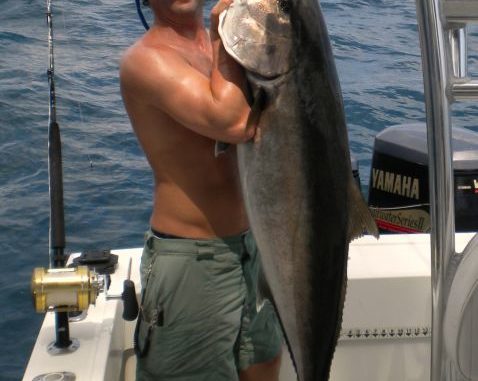
Amberjack are thick in 250- to 400-foot depths, yellowfin and blackfin tuna teem around floater rigs
Snapper season was explosive but short lived, so offshore anglers turned their energies to chasing heavier monsters. Now that amberjack season has reopened and is in full swing, Capt. Darrel Carpenter of Reel Screamers Charters has been pulling them up in droves.
“They’re all over the canyon rigs right now,” Capt. Carpenter said. “They definitely have some bruisers out there. I’ve been catching them in places that I never even knew there were amberjack. I went for grouper in 200 feet and pulled up an amberjack.“You want to fish them anywhere from 250 to 400 feet; any deeper and you’ll start losing them because they like to stay a certain distance from the bottom.”
According to Carpenter, amberjack usually stay in the middle water column around 150 to 250 feet, depending on the depth. Out-of-season red Snapper will often take a bite at bait intended for amberjack in this depth range, so Carpenter upsizes his hooks.
“I like using big, live hardtails for amberjack on 16/0 hooks,” he said. “It keeps the red snapper and small amberjack away. I’ve used jigs before but I find that I catch smaller amberjack when I use them.”
Getting these baits down to the fish is a matter of using the correct weight for the current conditions.
“Just remember that the current may be different on top than it is in the middle water columns,” Carpenter said. “I’ve had it to where it actually flows in the opposite direction or is stronger below.
“The weight that you use should always depend on the strength of the current.”
After catching amberjack during the hot daytime hours, a nighttime tuna run is always in the cards for those who have enough fuel onboard.
Carpenter said the tuna have been a little finicky over the past few months, but the area around the deepwater floaters have been producing good bites at dusk and daylight.
The real question is what bait to use.
“I’ve been using threadfin herrings and small hardtails to catch my tuna, but we’ve only been catching them at night,” Carpenter exlained. “If the yellowfin just aren’t turning on, you can always catch blackfin by the dozens with a jig or go after swordfish if you have the right equipment.
Experienced recreational fisherman Stephen Sonnier has a different approach: Sonnier believes flying fish are far superior to threadfin and hardtail as nightime bait.
“At night, flying fish is the bait to use,” Sonnier said. “We usually just spotlight them; you need a boat with a good bit of light on it to spot the them (the flying fish). Then just catch them with a cast-net or just a bait net.
“Around the floaters out of Venice at night, you can just throw (flying fish) out alive and drift them. After you put them out you should have a big nice tuna on within a few minutes.”
Find more fishing reports — and add your own — in the Fishing Forum. Not a member yet? It’s free, so click here to get started today!


